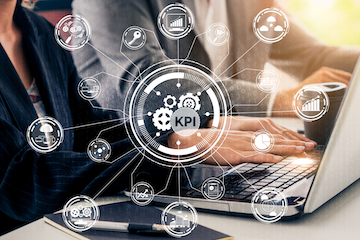Key performance indicators are metrics that indicate the health of a business at a given time, especially when compared to past performance and to other companies. A business’s KPIs typically change with new opportunities and challenges. But Gross Revenue and Gross Profit are universal KPIs for all ecommerce retailers, all of the time.
Gross Revenue
Three variables determine Gross Revenue for ecommerce merchants: number of visitors, conversion rate, and average order value.
Number of Visitors x Conversion Rate x Average Order Value = Gross Revenue
Obtain the data for each variable from your analytics, although the variable with the most impact on ecommerce revenue is typically conversion rate. Consider this example.
- Monthly visitors: 1,000
- Conversion rate: 2 percent
- Average order value: $100
- Monthly gross revenue: $2,000
Which variable would improve performance with the least investment and risk? Acquiring new visitors is expensive. And increasing the average order value typically requires sophisticated cross-sell and upsell tools that many smaller merchants either cannot afford or lack the traffic for data-powered recommendations.
But increasing the conversion rate from, say, 2 percent to 6 percent would increase revenue by 300 percent, to $6,000 per month.
Thus the quickest (and cheapest) way to boost revenue is to improve the conversion rate, typically by streamlining the checkout flow. Here are some ideas:
- Minimize the number of steps in your checkout.
- Do not cross-sell or upsell once the buyer has entered the checkout flow. Provide an easy path to purchase.
- Offer guest checkout, so visitors do not have to create an account at the start. Requesting an account at the end of the checkout process is much better.
- Add new payment methods that do not require credit card details, such as Apple Pay, PayPal, and Amazon Pay, among others. Consider offering a financing option for big-ticket items.
- Ensure your website is fast and secure.
- Include shipping and tax estimates in the add-to-cart process early to eliminate surprises in the checkout process later.
- Provide complete order details throughout the checkout so buyers can easily confirm items, quantities, and prices.
- Ensure forms and error messages are clear as to what is required. Be explicit, for example, about password requirements — letters, numbers, symbols. Don’t make visitors guess.
- Allow shoppers to save their cart or wish list to access later. This may require creating an account.
- Deploy retargeting campaigns one day (not minutes) after shoppers abandoned their carts.
- Optimize the checkout for mobile. While challenging, this design effort could be the biggest investment with the most impact.
- A/B test every aspect of your checkout process — fonts, forms, calls-to-action, button colors, button shapes, everything.
In my experience, the top ecommerce performers typically have the highest conversion rate, not necessarily the most visitors or the highest average order value. Large retailers focus on conversion rates daily.
Depending on the category, conversion rates for retailers range from 1 percent to more than 10 percent. The range is more dramatic in B2B commerce. If your business is at the low end, redesign your cart and checkout flow.
Gross Profit
The second universal KPI for ecommerce retailers is Gross Profit.
Gross Revenue – Cost of Good Sold = Gross Profit
By purchasing inventory at the lowest possible price and selling at the highest, your gross profit and gross profit margin will increase.
[Gross Profit ÷ Gross Revenue] x 100 = Gross Profit Margin
Many ecommerce retailers focus on revenue and ignore cost of goods sold. But the latter is just as important and is often easier to improve than revenue.
Like conversion rates, gross profit margins vary widely by category and industry. Regardless, focus on improving yours every day. When possible, buy in bulk to lower your cost of goods sold. Consider creating your own private label brands as a way of avoiding price competition.
Also, try premium-pricing strategies. Target marketing campaigns at your most loyal customers as they are often less price-sensitive than first-time buyers.
Many other expenses affect overall profitability, including wages, shipping costs, rent, equipment, licensing fees, and supplies. Certainly those are important. But if you continually lower inventory costs and increase your conversion rate, however small the improvements, your revenue and gross profit will steadily improve.







